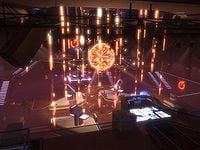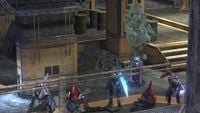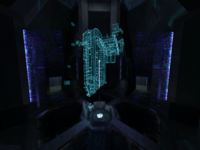Holography: Difference between revisions
From Halopedia, the Halo wiki
m (→Gallery: added the holo) |
|||
| Line 36: | Line 36: | ||
File:Holography_civilian_welcome.jpg|A holographic sign showing the word "welcome" in different languages on the [[Quito Space Tether]]'s orbital station. | File:Holography_civilian_welcome.jpg|A holographic sign showing the word "welcome" in different languages on the [[Quito Space Tether]]'s orbital station. | ||
File:Epitaph symbol.png|An enigmatic Forerunner hologram on [[Epitaph]]. | File:Epitaph symbol.png|An enigmatic Forerunner hologram on [[Epitaph]]. | ||
File:ReachHolo.jpg|The Holgram armor Ability in Halo: Reach. | |||
</gallery> | </gallery> | ||
Revision as of 12:28, March 18, 2011
Template:Ratings Template:SeeWikipedia
Holography is a technological system that forms a visual representation of an object in three physical dimensions, as opposed to the planar image of traditional screens that simulate depth through a number of different visual effects. Holography is employed by the humans, the Covenant and the Forerunners in a variety of functions - communications, battle and sensor displays, and as distractions and decoys. Devices used to project holograms are commonly referred to as Holotanks.
What is generally, and incorrectly, referred to as a "hologram" in most science fiction, including the Halo series, is actually a volumetric display. True holograms are not three-dimensional images. More specifically, Halo "holograms" seem to be of the static volume type, creating an actual three-dimensional image rather than creating the illusion of it.[1]
Applications
Human

The UNSC uses holographic technology in a variety of ways. Artificial Intelligences, such as Cortana, project holographic representations of themselves for personal communications with humans, with each AI taking a unique appearance of their own choice. The UNSC also uses holograms for communications between individual humans. The commanding officer of one ship may "appear" on another to deliver a message when normally access between the two vessels is restricted. Many UNSC warships, such as the UNSC Spirit of Fire and the UNSC Say My Name had holographic tables, used to project topographical maps or other images for tactical purposes.
Holography also has many civilian uses. For example, some nightclubs such as Club Errera make extensive use of holograms.[2] Humans also use holographic technology to display holographic "photographs", referred to as Holo-Stills. Holographic tape is used to display information on the sides of civilian vehicles.[3]
Covenant

The Covenant's holographic technology is also based primarily on that of the Forerunners, and though superior to UNSC technology it still pales in comparison. Covenant often utilize stationary Holotanks much like the UNSC, but also portable projectors. The Covenant use holograms for visual displays of space and ground combat, allowing a better general view of the action and better coordination.[4] Holograms are also used as decoys, through devices known as Holo-Drones, able to generate their own shields and weapons to give the illusion of reality. One of these was used by the Heretic Leader before his death at the hands of the Arbiter.[5] The Covenant also utilize less sophisticated holographic decoys in the field, a technology which has also been replicated by the UNSC.[6]
As shown by the ability of Holo-Drones to use weaponry, certain Covenant holograms are somehow capable of physically interacting with their environment. The Prophets, in particular, make extensive use of holography in their governance of the Covenant. Religious sermons, such as those by the Prophet of Truth[7] and Prophet of Regret[8], are transmitted holographically, allowing the Prophets to preach from the relative safety of their point of transmission while protected by armed guards.
Forerunner

Though now extinct, the Forerunners were true masters of holography. Their projections were accurate far beyond UNSC or even Covenant capabilities, able to appear as solid and actual objects. Holograms were used on Alpha Halo for a visible representation of the ringworld, and on the Ark for each of the Halo's and for a visual demonstration by 343 Guilty Spark on the Halo Array's capabilities. It is also notable to mention that many of the Forerunner terminals and nodes that can be activated, particularly in Halo 3, as holograms, yet apparently feel solid and can be pressed by the Master Chief. This could just be him passing his hand over the hologram, but in-game he appears to actually touch them. This is likely, as the Forerunner have proven their capability to produce 'Hard Light' holograms; the barriers in Halo Wars, the multiple light bridges and barriers (energy bridge, barrier tower) that have appeared throughout the series.
The Forerunner ruins underneath CASTLE Base, despite eons of neglect, were still capable of projecting myriad environments from hundreds of worlds, likely a representation of former Forerunner colonies.
Gallery
- 1220655526 Hologram2.jpg
A Covenant Holo-Drone, used to project holographic illusions, or to communicate over distance.
A holographic sign showing the word "welcome" in different languages on the Quito Space Tether's orbital station.
- Epitaph symbol.png
An enigmatic Forerunner hologram on Epitaph.
- ReachHolo.jpg
The Holgram armor Ability in Halo: Reach.
Sources
- ^ Wikipedia's article on Holography
- ^ Halo: Reach, campaign level, New Alexandria
- ^ Halo: Contact Harvest, "chapter 5", page 77
- ^ In the background on the Shadow of Intent
- ^ Halo 2, campaign level, The Heretic
- ^ Halo: Reach
- ^ Halo 3, campaign levels, Tsavo Highway, The Storm, The Ark and The Covenant
- ^ Halo 2, campaign levels, Delta Halo and Regret

